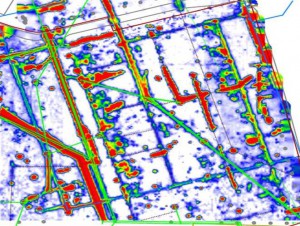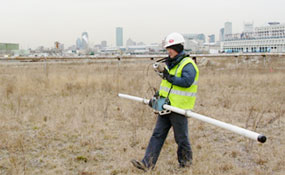Electromagnetic Induction
Electromagnetic induction (EM) methods allow for the rapid acquisition and interpretation of large quantities of data, making it cost effective for many projects. EM can be used to detect and locate both metal objects and zones of conductive contamination. It is the only widely available geophysical technique that is sensitive to the presence of both ferrous and non-ferrous metal objects. EM complements both magnetics and ground penetrating radar (GPR).
Frequency domain EM instruments measure the apparent conductivity of the subsurface, including effects of the soil, bedrock fractures, contaminants, metal objects, and ground water. Variations in apparent conductivity may indicate changes in composition, layer thickness, or moisture content. The presence of buried metal such as drums, USTs,and/or utilities strongly affect EM response. Some time domain EM instruments are specifically designed to be sensitive only to the presence of metal objects and are used as precision metal detectors.
Data are acquired at single stations and/or continuously along lines. Our digital field data recording capability allows us to collect and interpret data both rapidly and accurately. We use a variety of EM instruments and data collection methodologies, including standard profiling, multiple coil spacing, conductivity sounding, and downhole tools designed for used in open holes or in PVC cased borings. Such flexibility allows us to design a program to meet your needs.
Since no two projects are alike, the depth and diversity of our experience provide distinct advantages for our clients.
Electromagnetic induction surveys have certain limitations. They may be unsuitable for examining highly industrialized and/or urbanized areas where cultural features such as buildings, pipelines and power lines may interfere with the collection of accurate data. Electromagnetic induction is also unsuitable for locating small isolated objects on a large site.
We can provide you with an accurate assessment of your requirements to determine whether or not the use of electromagnetic induction is appropriate at a particular site.
General Applications
- Environmental audits and site assessments

- Evaluation of active and inactive industrial facilities
- Groundwater resource studies: mapping and plume delineation
- Public / private remedial investigations and feasibility studies
Specific Applications
- Detect and locate buried drums, underground storage tanks, and utilities
- Delineate boundaries of waste pits, landfills, and trenches
- Locate and define contaminant plumes
- Find water resources
- Determine lithology
- Detect and determine the orientation of fractures and faults



